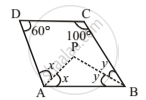Advertisements
Advertisements
प्रश्न
ABCD is a quadrilateral in which measures of angle D and angle C are 60 degrees, and 100 degrees respectively. If the internal bisectors of angle A and angle B meet at P, then measure of angle APB is
विकल्प
80°
90°
100°
110°
उत्तर
80°
Explanation:

Let ∠BAD = 2x and ∠ABC = 2y.
then, in quadrilateral ABCD,
∠(A + B +C +D) = 360°
2x+ 2y +100° + 60° = 360°
2 (x + y) = 200°
∴ (x + y) = 100° .............(i)
As, AP and BP are angle bisector of ∠A and ∠B respectively
Then, ∠BAP = x and ∠ABP = y.
Again in ΔAPB, the sum of angles 180°
APPEARS IN
संबंधित प्रश्न
If y = `"sin"^-1 (- 1/(1 + "x"^2)) , "then" "dy"/"dx"` is equal to:
If the sum of two unit vector is also a unit vector then the magnitude of their difference will be:
`lim_(x->0) (sqrt(1+"x")- sqrt (1 - "x"))/"x"` is equal to:
The amplitude of `1 -sqrt "3i"` is:
A polynomial of degree ‘3’ is called
LCM of 22, 54, 108, 135, 198 is
If the fractions `5/14, 6/11, 7/9, 8/13` and `9/10` are arranged in ascending order of their values, which one will be the fourth?
If `11 5/21` is subtracted from `15 3/14` and the difference is multiplied by 504, what will be the number?
Five consecutive even integers are such that two times the second integer is ten more than the 5th integer. Find the sum of all five integers.
